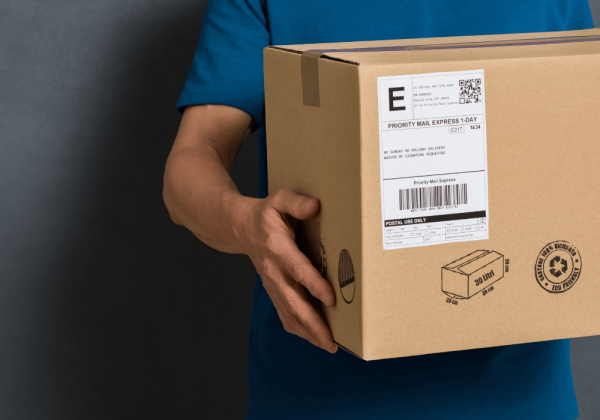If you’re an Amazon seller, you know that shipping costs can significantly impact your profit margins. While the actual weight of a package is a straightforward factor, there’s another, often more critical, metric that carriers use: dimensional weight. Have you ever shipped a large, lightweight item and been surprised by the high cost? The reason is likely dimensional weight, or DIM weight.
Understanding how dimensional weight works is essential for any e-commerce business looking to manage and reduce shipping expenses. This guide will break down what dimensional weight is, how carriers like FedEx, UPS, and Canada Post calculate it, and why it’s a critical factor for Amazon sellers. Mastering this concept can help you package your products more efficiently and avoid unexpected shipping charges.
What Exactly Is Dimensional Weight?
 Dimensional weight is a pricing technique used by shipping carriers to determine the cost of a shipment. It’s a calculation that considers a package’s density—that is, the amount of space it occupies in relation to its actual weight. The core idea is that the space a package takes up on a truck or airplane is just as valuable as its weight.
Dimensional weight is a pricing technique used by shipping carriers to determine the cost of a shipment. It’s a calculation that considers a package’s density—that is, the amount of space it occupies in relation to its actual weight. The core idea is that the space a package takes up on a truck or airplane is just as valuable as its weight.
Think about it from the carrier’s perspective. A truck can be filled with large boxes of pillows long before it reaches its maximum weight capacity. In this scenario, the carrier loses potential revenue because they can’t fit any more packages on the truck, even though it’s not “full” in terms of weight. Dimensional weight allows carriers to charge for the volume a package consumes, ensuring they are compensated for the space, regardless of the actual weight.
Carriers will calculate both the actual weight and the dimensional weight of your package. They will then charge you based on whichever number is higher. This is why a lightweight but bulky item, like a case of paper towels or a bicycle helmet, can be surprisingly expensive to ship.
How Do Carriers Calculate Dimensional Weight?
While the specific formulas can vary slightly between carriers, the basic calculation for dimensional weight is the same. You need to know the three dimensions of your package: length, width, and height.
The standard formula is:
(Length x Width x Height) / DIM Divisor = Dimensional Weight
The “DIM Divisor” is a number set by the carrier that represents the volume of a package per pound (or kilogram). This divisor is the key variable in the equation and can differ between carriers and service types (e.g., domestic vs. international).
Let’s look at an example. Suppose you are shipping a package with the following characteristics:
- Dimensions: 18″ x 12″ x 12″
- Actual Weight: 10 lbs
- Carrier’s DIM Divisor: 139 (a common divisor for domestic shipments in North America)
First, calculate the cubic volume of the package:
18 x 12 x 12 = 2,592 cubic inches
Next, divide the volume by the DIM divisor:
2,592 / 139 = 18.65 lbs
In this case, the dimensional weight is 18.65 lbs. The carrier will round this up to the next whole number, making the billable weight 19 lbs. Since the dimensional weight (19 lbs) is greater than the actual weight (10 lbs), you will be charged for a 19-pound package.
Common DIM divisors used by major carriers for daily rates are:
- FedEx: 139
- UPS: 139
- Canada Post: 139 (or 5,000 for cm/kg)
It’s crucial to always check the current DIM divisor with your specific carrier and for the service you are using, as these numbers can change.
Why Dimensional Weight is Critical for Amazon Sellers
For Amazon sellers, particularly those using Fulfillment by Amazon (FBA) or Seller Fulfilled Prime (SFP), dimensional weight is a constant factor in the cost of doing business. Amazon itself has its own set of policies regarding package size and weight that align with carrier practices. Ignoring DIM weight can lead to several problems:
1. Inaccurate Shipping Cost Estimates: If you only calculate shipping costs based on actual weight, your estimates will often be too low. This can lead to you undercharging customers for shipping or, if you offer free shipping, absorbing unexpected costs that eat directly into your profits. Accurate DIM weight calculations are essential for proper budgeting and pricing strategies.
2. Increased FBA Fees: Amazon uses dimensional weight to calculate its FBA fulfillment fees and monthly storage fees. Larger, lighter products will incur higher fees because they take up more space in Amazon’s fulfillment centers. By optimizing your packaging to reduce its dimensions, you can lower these fees and increase your profitability on each sale.
3. Risk of Carrier Chargebacks: Carriers have automated systems that scan and weigh every package that passes through their facilities. If their system calculates a higher-dimensional weight than what you declared, they will issue a chargeback for the difference, often with an added penalty fee. These unexpected charges can add up quickly. Proactive and accurate measurement is your best defense against these penalties. This is an area where a thorough Amazon vendor auditing process can uncover significant savings by identifying and disputing incorrect charges.
How to Reduce Costs Associated with Dimensional Weight
 Now that you understand the “why,” let’s focus on the “how.” Optimizing your packaging is the most effective way to manage and reduce DIM weight costs. Here are some actionable strategies:
Now that you understand the “why,” let’s focus on the “how.” Optimizing your packaging is the most effective way to manage and reduce DIM weight costs. Here are some actionable strategies:
1. Choose the Right-Sized Box: This is the most important step. Avoid using a box that is significantly larger than your product. Any empty space is wasted volume that you are paying to ship. Use the smallest box possible that still allows for adequate protective packaging material, like bubble wrap or air pillows. Keep a variety of box sizes on hand so you can always choose the most efficient option for each order.
2. Use Custom Packaging: For products you ship frequently, investing in custom-sized boxes can be a game-changer. While there may be an upfront cost, the savings on shipping over time can be substantial. Custom packaging eliminates excess space and ensures a snug, secure fit for your product, reducing both dimensional weight and the need for excessive void fill.
3. Consider Poly Mailers: For smaller, soft, or non-fragile items, poly mailers are an excellent alternative to boxes. They are lightweight and conform to the shape of the product, resulting in a much smaller dimensional footprint. Clothing, books, and other durable goods are perfect candidates for poly mailers.
4. Understand Carrier-Specific Programs: Some carriers offer special packaging or programs that can help mitigate DIM weight costs. For example, FedEx One Rate and UPS Simple Rate offer flat-rate shipping options based on box size, regardless of weight (up to a certain limit). If your products fit into these standard-sized boxes, you may be able to avoid DIM weight pricing altogether.
Dimensional weight is a fundamental part of the modern logistics landscape. By understanding how it works and taking proactive steps to optimize your packaging, you can protect your margins and build a more profitable e-commerce business. Don’t let your shipping strategy be an afterthought; make it a core component of your operational planning. Regularly auditing your carrier invoices for incorrect dimensional weight charges is another critical step. Mistakes happen, and without a diligent review process, you could be overpaying without even realizing it.
If you’re looking to gain better control over your shipping expenses and ensure you’re not falling victim to incorrect carrier fees, our team at RefundPros is here to help. We specialize in identifying and recovering funds from shipping carrier errors. Ready to see how much you could be saving? Reach out today for a consultation.


